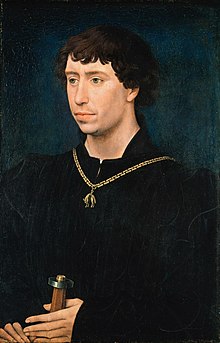
Back Karel die Stoute Afrikaans Karl der Kühne ALS شارل الجريء Arabic شارل التانى (الجرىء) ARZ Carlos el Temerariu AST Cəsur Karl Azerbaijani چارلز مارتین AZB Карл Смелы Byelorussian Шарл Дръзки Bulgarian Charlez an Her Breton
| Charles the Bold | |||||
|---|---|---|---|---|---|
 Charles the Bold in about 1460, wearing the collar of the Order of the Golden Fleece, painted by Rogier van der Weyden | |||||
| Duke of Burgundy | |||||
| Reign | 15 June 1467 – 5 January 1477 | ||||
| Predecessor | Philip the Good | ||||
| Successor | Mary the Rich | ||||
| Born | 10 November 1433 Dijon, Burgundy | ||||
| Died | 5 January 1477 (aged 43) Nancy, Lorraine | ||||
| Burial | |||||
| Spouses | |||||
| Issue | Mary the Rich | ||||
| |||||
| House | Valois-Burgundy | ||||
| Father | Philip the Good | ||||
| Mother | Isabella of Portugal | ||||
| Religion | Roman Catholicism | ||||
| Signature | |||||
Charles Martin (10 November 1433 – 5 January 1477) called The Bold[a], was the last Duke of Burgundy from the Burgundian cadet branch of House of Valois from 1467 to 1477. He was the only legitimate son of Philip the Good and his third wife, Isabella of Portugal. Appointed as the Count of Charolais upon his birth, Charles vied for power and influence even before succeeding his father. He had a deep rooted rivalry with Louis XI, the King of France, which was the cause to many disputes and events during his life, starting with the War of the Public Weal, a revolt of French vassals under the leadership of Charles.
After ascension to the Duchy of Burgundy in 1467, Charles began pursuing his ambitions: independence from France and forging a kingdom from the North Sea in the north to the borders of Savoy in the south. For this purpose, he added Guelders and Upper Alsace into his realm, and tried to become the King of the Romans, and gradually became an enemy to the Germans. Charles forged many alliances, marrying Edward IV's sister, Margaret of York for an English alliance and arranging the betrothal between his sole child, Mary, with Maximilian, the son of the Holy Roman Emperor, Frederick III.
As a patron of arts, he supported the production of illuminated manuscripts and music, himself being a composer and valid musician. His court was famously seen as a centre of arts, chivalry and etiquette and would keep this reputation even after his death. He was obsessed with order and regulation and wrote many ordinances throughout his rule, dictating military matters, legislations, and diplomacy to the smallest of detail. A religious person, his patron saint was Saint George and he was asked constantly by the Pope and the Venetians to undertake a crusade against the Ottoman Turks.
Towards the end of his life, Charles became engaged in a multinational conflict called the Burgundian War (1474–1477), during which, he tried to protect his rights over Upper Alsace and also annex lands belonging to the Swiss Confederacy. After his unsuccessful siege upon Neuss, he confronted the Swiss in the battles of Grandson and Morat, all of which ended with his defeat. At last, he was killed at the Battle of Nancy on 5 January 1477, fighting against René II of Lorraine and his Swiss army. His death brought an end to the prestigious Burgundian state, and his dynasty would end a generation later when his daughter, Mary of Burgundy died and was succeeded by her son, Philip of Austria.
- ^ Van Loo 2021, p. 287.
Cite error: There are <ref group=lower-alpha> tags or {{efn}} templates on this page, but the references will not show without a {{reflist|group=lower-alpha}} template or {{notelist}} template (see the help page).
© MMXXIII Rich X Search. We shall prevail. All rights reserved. Rich X Search